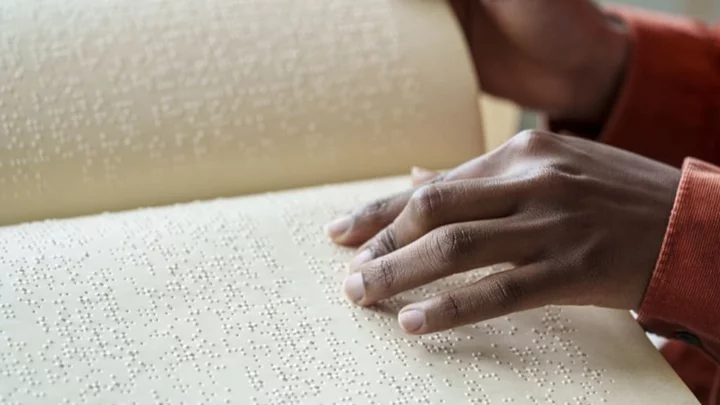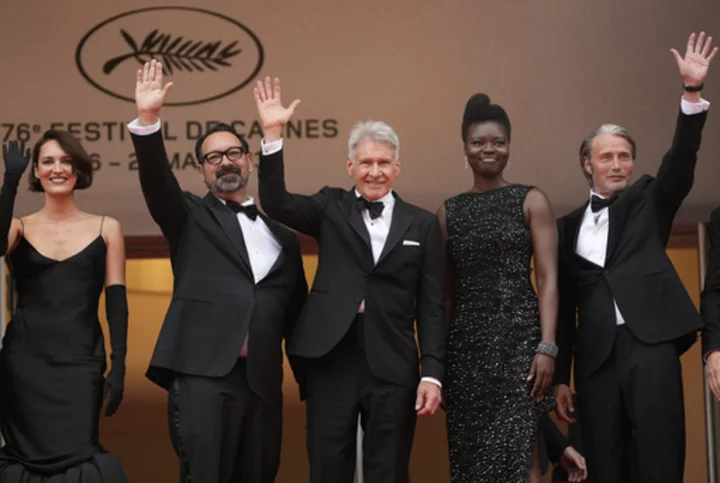Braille is a tactile system that blind people use to learn to read and write, invented in 1824 by a blind French educator named Louis Braille. He revolutionized an existing writing and reading system that allowed blind people to enjoy books and communication. I certainly don’t know how I would’ve learned and communicated without reading and writing braille.
I think every generation of blind students wonders how those before them managed to learn using the technology on hand. I had a teacher who made me practice braille with a torturous slate and stylus. Think of it as the braille equivalent of pencil and paper in which the user punches out every … single … dot … by hand using a kind of template. Later on, I used a Perkins Brailler—a typewriter where paper is fed into the machine and you press keys to punch the dots.
Today, students just starting their braille education have smart technology devices. Perhaps those who come after them will have something fresher and newer at their fingertips.
Here are 10 other cool facts about braille you should know.
1. Louis Braille injured himself with an awl.
Louis Braille was born in the village of Coupvray, France, in 1809. When he was 3 years old, he accidentally stabbed himself in his right eye with an awl, a pointed tool from his father’s harness shop—ironically, the very tool he’d use later in his life to press dots into paper while perfecting braille.
There was nothing anyone could do to save his vision, and sadly, his left eye also became infected. He was totally blind by the age of 5. When he was 10, a local priest convinced the only school in Paris for blind students, the Royal Institute for Blind Youth, to offer the young boy a scholarship. He attended and eventually taught at the school.
2. Braille developed his reading and writing system when he was only 15.
At the Royal Institute, students learned how to read by touching large, raised Latin letters embossed on paper, a method championed by the school’s founder, Valentin Haüy. The system also allowed students to learn mathematics and music, but it offered no framework for teaching pupils to write.
While at the institute, Louis Braille learned about a military code developed by Charles Barbier and the French army. Known as Écriture Nocturne (“night writing”), the code translated phonetic sounds into grids of raised dots in two columns of six dots each, with each grid representing one sound. By following the dots via touch, soldiers could communicate in the dark without the risk of discovery.
Braille adopted this system and created a more streamlined format of six raised dots (two columns of three dots each), known as cells. These dots can be put into 63 combinations of letters, numbers, contractions, and forms of punctuation. On the top left going down are dots one, two, and three; on the right are dots four, five, and six.
3. Braille has shortcuts.
The most basic forms of literary braille are uncontracted and contracted. Uncontracted braille can be compared to writing out every single letter in print. Contracted braille is a shorthand, abbreviated version. For example, uncontracted braille is like writing do not and contracted braille is like writing don’t.
4. Braille also has special codes for math and other subjects.
Dr. Abraham Nemeth, a mathematician who was blind, invented codes and braille symbols for communicating advanced math like algebra and calculus after being frustrated by the limitations of the original braille system. The Nemeth Code, introduced in 1950, is now used widely in universities and textbooks. More recently, braille code for writing email and website addresses (computer braille) has been made available. People can also use another code invented by Louis Braille, specifically for learning music.
5. A blind person can read braille faster than a sighted person can read print.
A sighted person can read an average of 300 words per minute. Reading braille, a blind person can read an average of 400 words. Braille is read with both hands: one hand lightly skims over the line of dots while the other remains still at the beginning of the next line.
6. Braille books take up a lot of shelf space.
Thanks to their tactile nature, braille books are much larger than print books. The print version of Harry Potter And The Goblet of Fire, for example, is one volume. In braille, it’s 10. The braille version of Webster’s Unabridged Dictionary comes in 72 volumes. You’d need a pretty massive bookcase to store it.
7. Popular games, toys, and other products have braille versions.
Braille dice and dominos, card games like Uno, and classic board games like Monopoly and Scrabble are available. Children can play with balls that whistle or beep, braille LEGO bricks, puzzles, craft supplies, and drawing implements in braille. There’s even a braille Rubik’s Cube.
For adults, there are also braille products for cooking, baking, storing, and labeling, such as talking timers, talking scales for weighing food, braille thermometers, and braille cookbooks. Office supplies and travel items also come in braille editions.
8. Braille devices integrate seamlessly with computers and the internet.
Braille readers and writers may use refreshable braille devices like a braille display that connects to a computer and internet via Bluetooth or a cable. The user places the braille display under the computer keyboard, where they can then check what they’ve written. This device can be manually refreshed or automatically updated to show in braille what’s on the computer screen.
Braille notetakers and smart displays are two other refreshable braille devices users can buy. A notetaker allows for the user to take notes, stream music, read books, and browse the internet through a single device. Smart displays can be used in tandem with computers and smartphones.
Like sighted folks, I can choose to read a book with one of many apps at my disposal. I can download something from Book Share, a service available to those with print disabilities. Or I can browse the expanding catalog from the National Library Service For The Blind and Print Disabled, which is administered by the Library of Congress.
9. There are 133 braille “languages.”
Technically, braille is not a language—it’s a writing system in which different languages can be expressed. Blind people in English-speaking countries learn English braille. There’s also French, Spanish, Hebrew, Chinese, and dozens of other braille codes that speakers of those languages can use to read and write.
Currently, there are braille codes for 133 languages, all compiled in a reference book called World Braille Usage and published by the Perkins School for the Blind. The latest edition was expanded to include codes for eight Indigenous languages, such as Iñupiat, Khmer, and Ndebele.
10. There’s a reason why braille appears on drive-through ATMs.
The Americans With Disabilities Act (ADA) requires that ATMs must be accessible to all users. Blind people need to be able to operate them independently. The same goes for elevators, restrooms, and all other public accommodations.
This article was originally published on www.mentalfloss.com as 10 Brilliant Facts About Braille.









